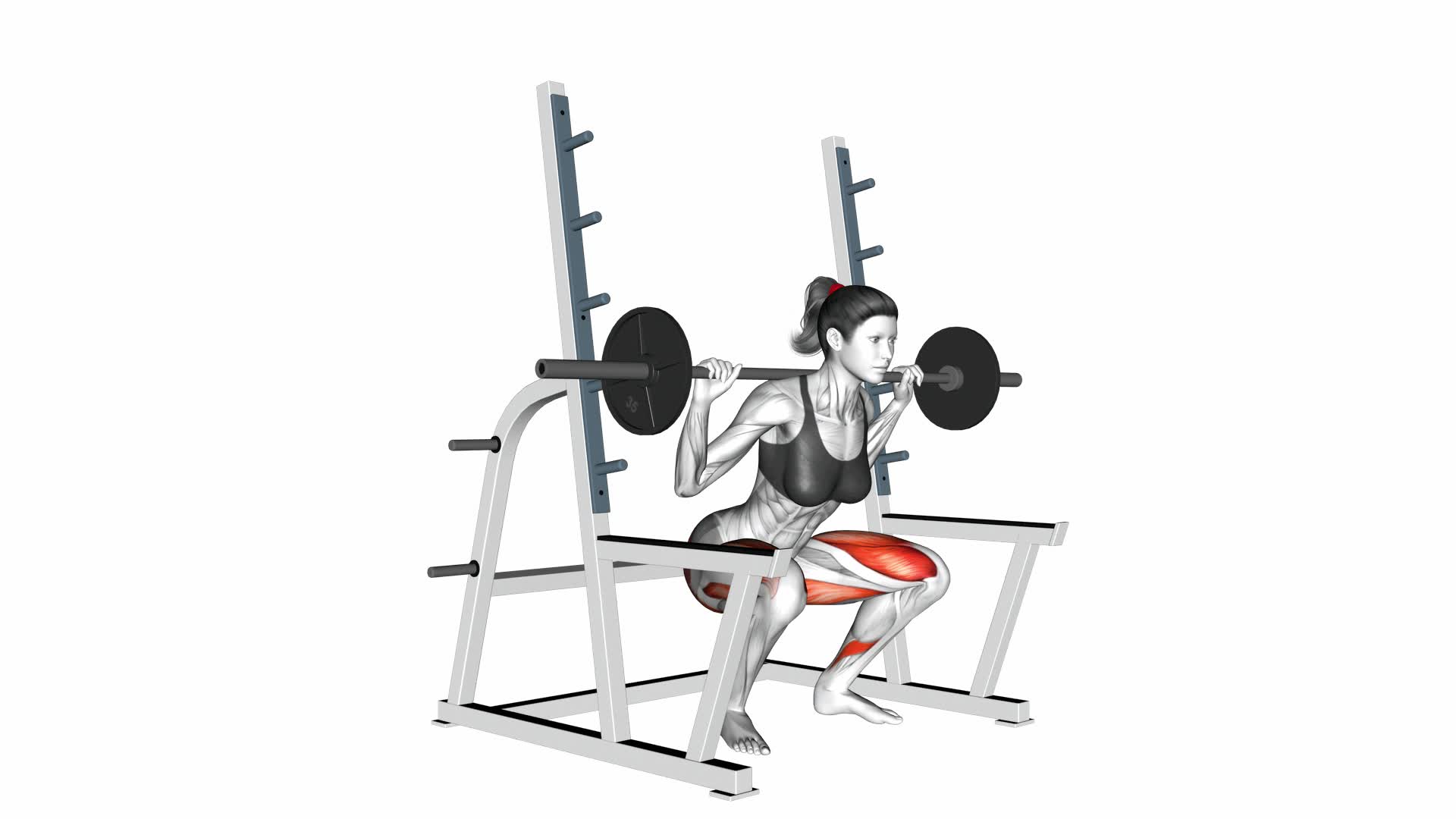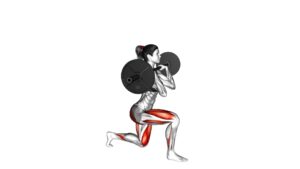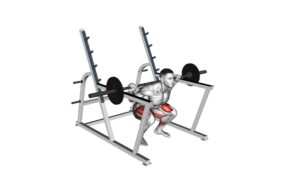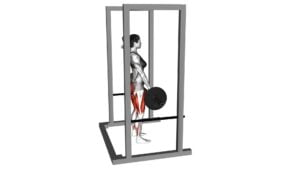Barbell Full Squat (With Rack) – Video Exercise Guide & Tips

Are you looking to master the barbell full squat? Look no further!
Watch This Exercise Video
This video exercise guide and tips will show you the proper technique and form for this challenging exercise. Learn how to set up and position the rack correctly, while avoiding common mistakes.
Plus, discover effective tips for progression and increasing weight.
Get ready to take your squat game to the next level!
Key Takeaways
- The barbell full squat is a compound exercise that targets multiple muscle groups.
- Proper set-up and rack position are important for a safe and effective squat.
- Technique and form, including maintaining a neutral spine and proper squat depth, are crucial for maximizing the benefits of the exercise.
- Progression in weight should be done gradually and with a focus on maintaining proper form.
Benefits of the Barbell Full Squat
You should regularly incorporate the barbell full squat into your workout routine to maximize its benefits. The barbell full squat is a compound exercise that targets multiple muscle groups, making it an efficient and effective exercise choice.
Unlike other barbell squat variations, such as the front squat or the overhead squat, the full squat allows for greater activation of the glutes, hamstrings, and quadriceps. By engaging these large muscle groups, you can increase overall strength and power in your lower body. Additionally, the full squat also engages the core muscles, helping to improve stability and balance.
This exercise can also contribute to improved mobility and flexibility in the hips and ankles, which is beneficial for activities such as running and jumping. By incorporating the barbell full squat into your workout routine, you can effectively target multiple muscle groups and enhance your lower body strength and power.
Now, let's move on to discussing the proper set-up and rack position for the barbell full squat.
Proper Set-Up and Rack Position
To properly set up and position the barbell for a full squat, begin by adjusting the rack height to a level that allows you to comfortably unrack the barbell. This is an important step because it ensures that you can safely lift the barbell off the rack without straining your back or shoulders. Once the rack height is set, stand facing the barbell and position yourself under it so that it rests across your upper back, just below your neck. Make sure to grip the barbell with a wide hand placement, as this will provide better stability during the exercise.
Before starting your full squat, it's crucial to warm up your muscles. This can be done through dynamic stretches or light cardio exercises, such as jogging or jumping jacks. Warming up prepares your body for the squatting movement and helps prevent injuries.
There are different variations of squats that you can incorporate into your workout routine. Some common variations include front squats, goblet squats, and sumo squats. These variations target different muscles and can add variety to your training regimen.
Now that you have properly set up the barbell and warmed up, it's time to focus on the technique and form for the barbell full squat.
Technique and Form for the Barbell Full Squat
Mastering the technique and form for the barbell full squat is crucial for proper execution and maximum results. The barbell full squat is a fundamental movement that targets multiple muscle groups, including the quadriceps, hamstrings, glutes, and core.
To perform the exercise correctly, start by standing with your feet shoulder-width apart and the barbell resting on your upper back, secured in the rack. Take a deep breath and brace your core. Lower your body by bending at the hips and knees, keeping your chest up and your back straight. Squat down until your thighs are parallel to the ground, or lower if you have sufficient mobility. Be sure to maintain a neutral spine and avoid rounding your back.
To maximize the benefits of the barbell full squat, focus on maintaining proper squat depth and range of motion. This will help engage the targeted muscles effectively and prevent any potential injuries. Experiment with barbell squat variations to challenge your muscles and add variety to your training routine.
Remember to always prioritize good form and technique over heavy weights.
Common Mistakes to Avoid
One common mistake to avoid when performing the barbell full squat is improper foot positioning. Placing your feet too close together or too far apart can throw off your balance and compromise your form. To ensure proper foot positioning, stand with your feet shoulder-width apart and toes pointed slightly outward. This will provide a stable base of support and allow for proper alignment of your knees and hips throughout the movement.
Another common mistake is failing to maintain a neutral spine. It's crucial to keep your back straight and avoid rounding or arching your spine during the squat. This improper form can increase the risk of injury to your lower back. To maintain a neutral spine, engage your core muscles and focus on keeping your chest lifted throughout the movement.
Lastly, many people make the mistake of not going low enough during the squat. Partial squats limit the activation of the muscles in your lower body and can lead to imbalances and decreased strength gains. Aim to lower your hips below parallel, ensuring that your thighs are at least parallel to the ground. This full range of motion will maximize the benefits of the exercise and help prevent injury.
Tips for Progression and Increasing Weight
As you progress in your barbell full squat journey, it's important to gradually increase the weight you're lifting to continue challenging your muscles and promoting strength gains.
Here are some tips for progression and increasing weight:
- Progressive Overload: To continue making progress, you need to progressively increase the weight you're lifting. This can be done by adding small increments of weight each week or by increasing the number of repetitions or sets.
- Proper Form: Always prioritize maintaining proper form while increasing the weight. Proper form ensures that you're targeting the correct muscles and reduces the risk of injury. If you find it challenging to maintain proper form with heavier weights, consider seeking guidance from a qualified trainer.
- Safety Measures: When increasing the weight, it's crucial to prioritize safety. Always use a spotter when lifting heavy weights, especially if you're lifting to failure. Additionally, make sure to warm up properly before starting your workout and listen to your body to avoid overexertion or injury.
By implementing these progression techniques and prioritizing weightlifting safety, you can continue challenging your muscles and achieve strength gains.
Remember to always listen to your body and make gradual increases in weight to avoid injury and ensure continued progress.
Frequently Asked Questions
How Long Should I Rest Between Sets When Performing the Barbell Full Squat?
When performing the barbell full squat, it's important to rest between sets in order to properly recover and maximize your performance.
The length of your rest periods can vary depending on your fitness level and goals. Generally, resting for 1-3 minutes between sets is recommended.
However, you can modify the rest periods based on your individual needs and preferences. Remember to listen to your body and adjust accordingly to ensure you're getting the most out of your workout.
Can the Barbell Full Squat Be Modified for Individuals With Knee or Hip Issues?
If you have knee or hip issues, there are modified variations of the barbell full squat that you can try. These variations can help reduce stress on your joints and allow you to still reap the benefits of this exercise.
Incorporating the barbell full squat in your workout routine can improve overall strength and stability, as it targets multiple muscle groups.
Remember to consult with a professional before attempting any new exercises if you have existing injuries.
Are There Any Specific Breathing Techniques That Should Be Used During the Barbell Full Squat?
When performing the barbell full squat, it's important to focus on your breathing technique to ensure proper form and prevent common mistakes.
Take a deep breath in before descending into the squat, and exhale forcefully as you push back up. This helps stabilize your core and maintain proper spinal alignment.
Remember to avoid holding your breath during the movement, as it can increase intra-abdominal pressure and put unnecessary strain on your body.
Is It Necessary to Wear Weightlifting Shoes While Performing the Barbell Full Squat?
When performing the barbell full squat, wearing weightlifting shoes can be beneficial. They provide stability and support, allowing you to maintain proper form and technique. Weightlifting shoes have a raised heel, which helps with ankle mobility and depth in the squat.
Additionally, they have a solid base that enhances your balance and reduces the risk of injury. To ensure optimal performance, make sure to choose the right size and fit for your feet.
What Are Some Alternative Exercises That Can Be Incorporated to Complement the Barbell Full Squat in a Workout Routine?
Incorporating alternative exercises into your workout routine can complement the barbell full squat. By diversifying your routine, you can target different muscle groups and avoid plateauing.
Some options to consider include lunges, step-ups, and Bulgarian split squats. These exercises challenge your lower body in similar ways to the barbell full squat, helping to build strength, stability, and overall leg development.
Experimenting with these alternatives can enhance your training and provide variety to keep you motivated.
Conclusion
In conclusion, the barbell full squat is a highly beneficial exercise for building strength and muscle in the lower body. Proper set-up and rack position are crucial for executing the exercise safely and effectively.
Maintaining proper technique and form is essential to avoid common mistakes. Gradually increasing weight and following the provided tips will help in progression.
Incorporating the barbell full squat into your workout routine can lead to significant improvements in overall strength and muscular development.

Author
Years ago, the spark of my life’s passion ignited in my mind the moment I stepped into the local gym for the first time. The inaugural bead of perspiration, the initial endeavor, the very first surge of endorphins, and a sense of pride that washed over me post-workout marked the beginning of my deep-seated interest in strength sports, fitness, and sports nutrition. This very curiosity blossomed rapidly into a profound fascination, propelling me to earn a Master’s degree in Physical Education from the Academy of Physical Education in Krakow, followed by a Sports Manager diploma from the Jagiellonian University. My journey of growth led me to gain more specialized qualifications, such as being a certified personal trainer with a focus on sports dietetics, a lifeguard, and an instructor for wellness and corrective gymnastics. Theoretical knowledge paired seamlessly with practical experience, reinforcing my belief that the transformation of individuals under my guidance was also a reflection of my personal growth. This belief holds true even today. Each day, I strive to push the boundaries and explore new realms. These realms gently elevate me to greater heights. The unique combination of passion for my field and the continuous quest for growth fuels my drive to break new ground.







